Koblenz, the city where the Rhine and Moselle meet, is the oldest city in Germany. Here in the southwest of Germany, the city with Ehrenbreitstein Fortress forms the gateway to the Upper Middle Rhine Valley.
Sights in Koblenz – what not to miss?
Next to the fortress, the German Corner with the Kaiser Wilhelm Monument is the most famous place in Koblenz and many visitors have not discovered much more of the city during their visits. We have gone in search of clues and the most beautiful sights in Koblenz.
German Corner with the Kaiser Wilhelm Monument
The German Corner is certainly the most famous place in Koblenz. Here, at the confluence of the Moselle and Rhine rivers, stands the imposing equestrian statue of Kaiser Wilhelm. But wait… historically, the German Corner is located in a completely different place. Not far from the top of the place called Deutsches Eck is the inconspicuous remnant of the old city wall of Koblenz. The corner of this city wall is the actual German Corner and once stood directly on the water. The exact spot can be identified by a cross on the wall. It was only much later that the area in front of it was fortified and the large square with the monument was created.

If you want to know more about it, you can read detailed information in our article ” Deutsche Eck in Koblenz“.
Herz-Jesu-Kirche (Church of the Sacred Heart)
What a beautiful church! The Sacred Heart Church stands large and mighty on a busy street. Even from the outside, the building impresses me with its numerous curves and could almost be called a cathedral.
The Sacred Heart Church is a Catholic church from the 1900’s. It was built as part of the southern city development according to the plans of Ludwig Becker.
At the end of the 19th century Koblenz had over 30,000 inhabitants. The two existing Catholic churches Liebfrauen and St.Kastor were no longer sufficient. Then, in 1890, when large parts of the Prussian city fortifications were demolished and the city continued to expand, it was decided to build a new church. First, the parish church of St. Joseph was built, followed by the Church of the Sacred Heart.

I find it very exciting that part of a barracks was demolished for the construction of the church. The stones of this barracks were used for the construction of the church foundation.
During the Second World War, almost the entire city of Koblenz was destroyed. The church also suffered heavy damage and burned out. From 1950 the reconstruction began, which, however, brought slight changes to the church building.
Today, the church is not only one of the sights in Koblenz, but also a protected cultural monument and has been part of the UNESCO World Heritage Upper Middle Rhine Valley since 2002.
Old Prussian Government Building
As we walk along the Rhine, a large neo-Romanesque-style building catches our eye. On the Rhine side, the 158-meter-long building rises four stories high on a pedestal. It looks impressive and so we took a closer look.
The building is the old Prussian government building. Once it was the seat of the Prussian government of the government district Koblenz and today the BAAINBw is located here. When I was told that, I had a lot of question marks in my eyes, so here is the long version: Bundesamt für Ausrüstung, Informationstechnik und Nutzung der Bundeswehr (Federal Office for Equipment, Information Technology and Utilization of the German Armed Forces)… what else is there?

But back to the original use. After the building there, which had also been used by the Prussians, burned down in 1901, the government decided to erect a larger building. The Berlin building council Paul Kieschke was put in charge and a large government building was created that was connected to a mansion-like residence of the government president. Emperor Wilhelm II is said to have adapted the plans to his own ideas. Later, an extension wing was built, into which the main tax office moved.
If you walk around the complex, you will find a two-story building on the back side, which is located on a large square. Three copper sculptures depicting St. George and allegories of viticulture (female figure) and navigation (male figure) by the brothers Hugo and Ludwig Cauer characterize the façade.
The building is a listed monument and has been part of the UNESCO World Heritage Upper Middle Rhine Valley since 2002.
Four towers in the old town
Who now wanders through the old town of Koblenz in search of 4 towers, will look for a very long time for this sight in Koblenz. The 4 towers are namely 4 oriels, which are attached to 4 houses.

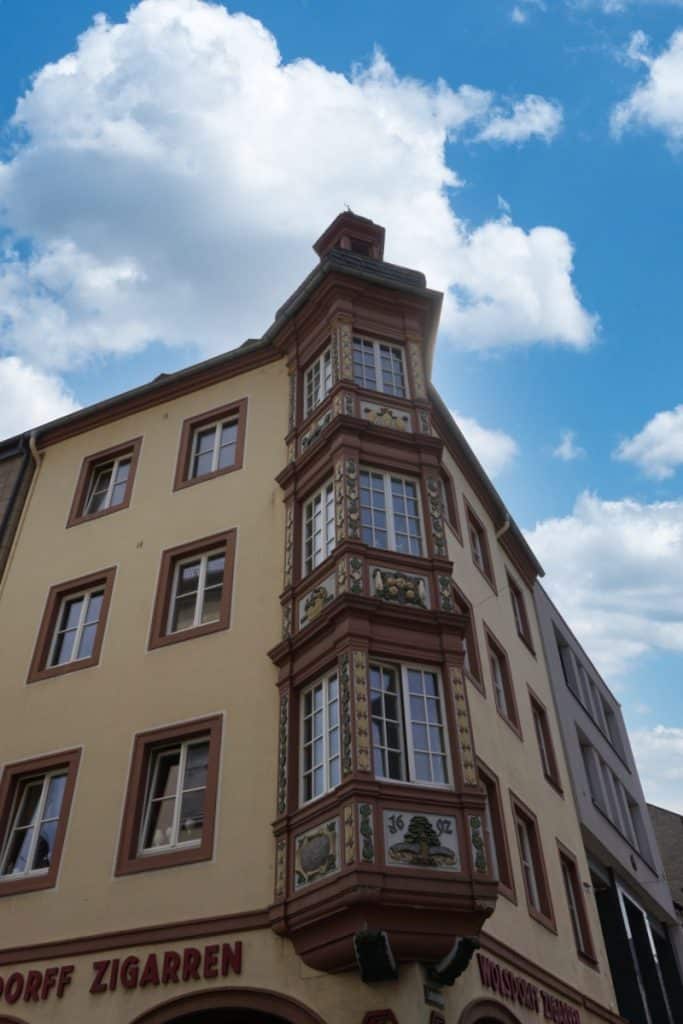
At the intersection of the streets Am Plan – Löhrstraße – Altengraben – Marktstraße there are 4 corner houses. Unfortunately, they are no longer the original buildings from 1608, but their successor buildings. Except for the house in Marktstraße 1, the other corner buildings were so destroyed in the Second World War that they were reconstructed only in 1949, 1950 and 1960.


I really like the bay windows. Each one is individually designed and beautiful. For example, there is a three-story oriel with the inscription “Zum grünen Baum” and a richly decorated two-story oriel with some half-timbering.
The entire ensemble is a listed building and has been part of the UNESCO World Heritage Upper Middle Rhine since 2002.
Erfinderbrunnen (Inventor’s Fountain)
In the pedestrian zone on a small square in front of the Löhrpassage is an exciting fountain. Here the water splashes and numerous funny figures entice to look at the fountain more closely.

The Inventor’s Fountain by Gernot Rumpf has stood in the city since 1983. In the vernacular it is only called “Noah’s Ark”, because it looks a bit like a ship with numerous animals. The figures, however, are not meant to show the animals on the ark, but represent allegories. For example, there is a bird dedicated to the airplane manufacturer Carl Clemens Bücker or a turtle on wheels that reminds of the automobile manufacturer Horch. The ship is supposed to be a reference to the Moselle and Rhine as the transportation routes for the region.
Opinions are divided on this fountain. Some, like me, like it and others find it just ugly. In any case, it is worth seeing.
Sights in Koblenz: Electoral Palace with Palace Park
The Electoral Palace of Koblenz is located directly on the banks of the Rhine. It was built after the old residence (Philippsburg Castle) was too dilapidated and no longer representative enough for the archbishop at the time. After many discussions, the Electoral Palace was finally built in the new town of Koblenz from 1777 to 1793.

In 1786, the then Elector Clemens Wenzeslau and his sister moved into the building, which was not yet completely finished. When the French revolutionary army approached during the First Coalition War, the elector fled and the city was taken. As a result, the planned design of the interior was never completed. However, the Elector managed to load everything that could be transported onto ships and bring it to Augsburg.
After the Elector’s escape, the castle was used as barracks and a military hospital, and from 1815 under the Prussians it was used only as barracks. From 1823 to 1842 the castle was the seat of various Prussian authorities and courts, and later it was the official residence of the Chief President of the Rhine Province.

What I find particularly interesting is the fact that between 1833 and 1852 an optical beam telegraph of the Prussian telegraph line Berlin-Cologne-Coblenz stood on the belvedere of the southern wing of the castle. It was the final station 61 of the line, which enabled astonishingly fast communication.
Whenever Frederick William IV was traveling in the Rhineland, he stayed overnight in Koblenz Castle. For this purpose, he had extra rooms redesigned according to his wishes. From 1850 to 1858, the future Emperor Wilhelm I and his wife, who liked to refer to the city as their Rhenish Potsdam, held office here as military governor for the Rhineland Province.
During the Second World War, the palace complex was almost completely destroyed. Reconstruction began in the post-war years. Externally, the old plans were followed, but inside, almost everything was built in the style of the 1950s and only a few rooms were restored according to the old model. Initially, the Allied Security Council used the building, later various federal authorities moved in.
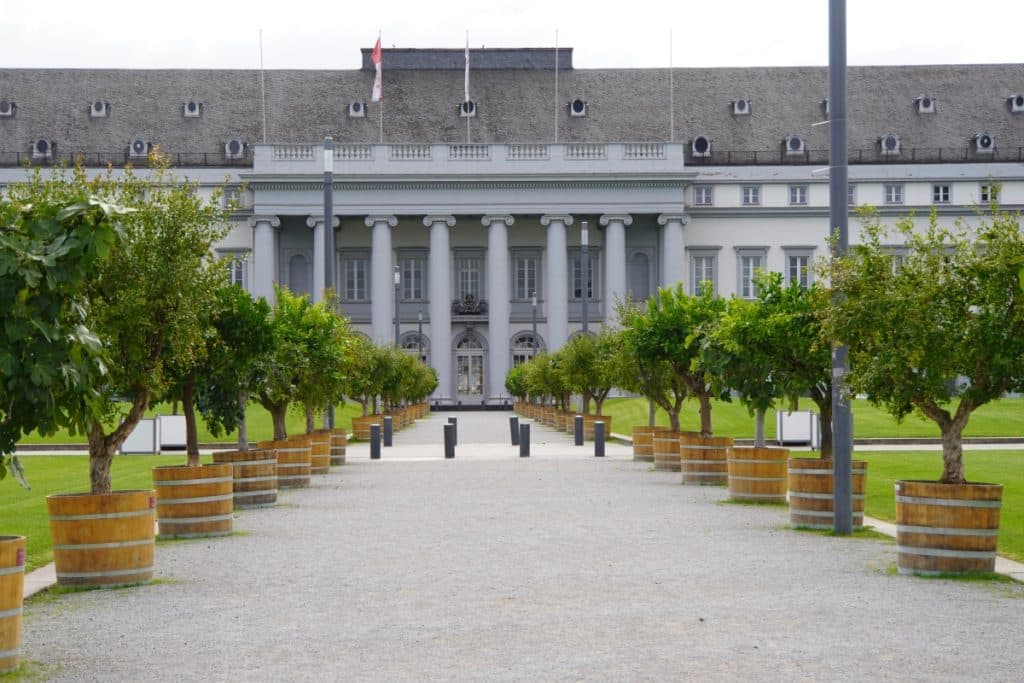
Anyone approaching from the city side walks across the large palace forecourt toward the building. The facade with the eight-columned portico impresses me very much. The semicircular circular buildings frame the palace square on both sides. Through an open, rather inconspicuous door, we pass through the building and stand on the Rhine side. Here is a small landscaped park where we discover the artwork “Vater Rhein und Mutter Mosel” (1854) by Hartung.

This building has also been on the UNESCO World Heritage List since 2002.
Görresplatz with history column
Rather by chance we passed the Görresplatz and discovered the history column. The fountain is a good 10 meters high and tells the story of Koblenz. The total of 10 scenes depicted on top of each other show of course only a small part of the over 2000 year old city history.
I find the representation very successful.

Fortress Ehrenbreitstein
One of the most famous sights in Koblenz is the Ehrenbreitstein Fortress. Located high above Koblenz on the banks of the Rhine, it not only offers a fantastic view of the city. The fortress can be visited and we were really impressed by it. What we experienced there, you can read in our article “High above Koblenz – Fortress Ehrenbreitstein“.

Cable car Koblenz
A ride on the Koblenz cable car to the Ehrenbreitstein is simply part of a visit to the city. The gondola floats comfortably over the Rhine and offers passengers an incomparable view over the Rhine, the Moselle and, of course, Koblenz.

More information about the cable car can be found in our article “Riding the cable car in Koblenz“.
Münzplatz with the Metternich House
The Münzplatz is located in the old town of Koblenz. It is located on the exact spot where the city’s mint was located until the beginning of the 19th century. Since the 11th century, coins could be minted in Koblenz. Of the former mint houses, only the mint master’s house, a simple baroque building, still exists today.

The Metternich House is located directly on Münzplatz today. In this house Klemens Wenzel Lothar von Metternich, the Austrian statesman, saw the light of day in 1773. Today, the building houses a museum of contemporary art and a youth meeting center.
Maatfrau sat zom Schutzmann
The mate woman is a bronze figure at the Münzplatz. She is sitting next to a constable (policeman). Here at the Mint Square was the police station 1. Every Saturday, when there was market on the square, the policemen helped the market women to carry their goods. In return, they received fresh vegetables.
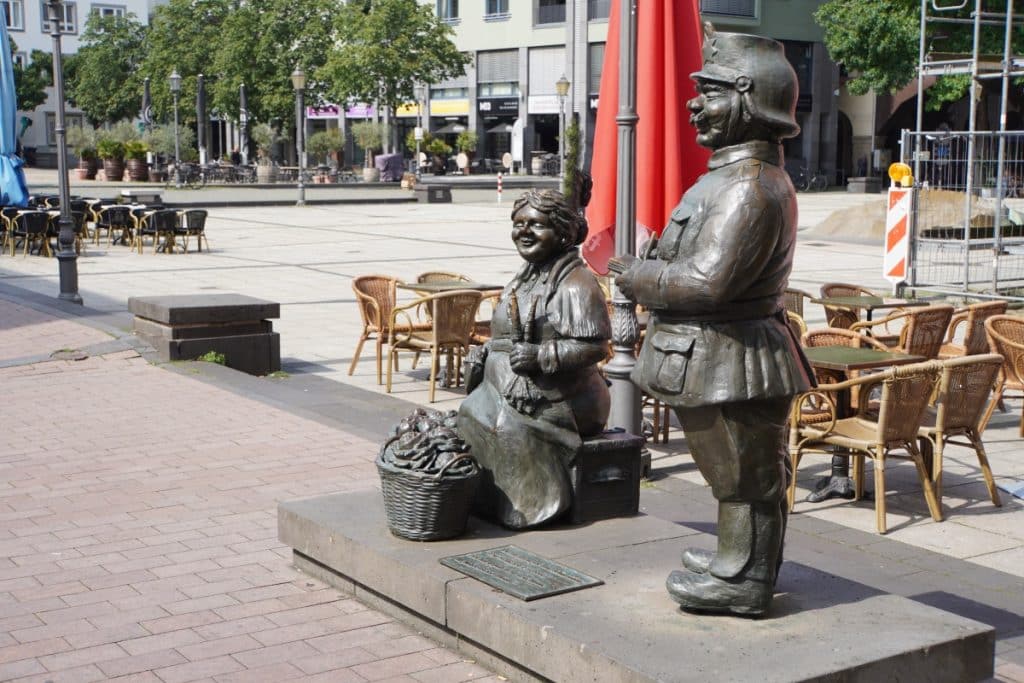
The figures were created by the sculptor Fritz Berlin (1924-1997). Between the figures you can read on a plate the saying: “Die Maatfrau sät zom Schutzmann, dat es mir jetzt zo bont. Do hat gepinkelt an mein Mann (= wicker basket with vegetables), dä Nobersch ihre Hond.”
Old castle
On the banks of the Moselle stands the Old Castle, a former electoral castle complex from the 13th century. For me, one of the little-noticed sights in Koblenz, but one that should not be overlooked.
Originally, there was a residential building there. With the extension of the Koblenz city wall around 1250, the archbishop had it rebuilt into a kind of Zwingerburg, which was completed in 1307. Directly next to the castle, the Balduin Bridge was built from 1342 as a connection to the other side of the Moselle.
Over the years and with many alterations, the building was used by electors, a tinware factory, the city savings bank, the city welfare office, Debeka and the Hitler Youth. After a complete renovation after the Second World War, the municipal library (until 2013) and the municipal archive moved into the Old Castle.

I am impressed by the mighty walls of the Old Castle. If you stand on the banks of the Moselle, you can see two small towers and the hipped roof very well. From the city side, I also like the building quite well. Here, however, it has lost for me the “heaviness and mightiness” and seems almost like a fairly normal building and not like a castle.
The protected cultural monument belongs to the UNESCO World Heritage Upper Middle Rhine Valley.
Water level house with water level gauge
On the bank of the Rhine stands the gauge house with the gauge clock. Today there is a restaurant in the gauge house. Originally, the building was erected in the 17th century as a Rhine crane. It was used as such until 1839, and then only as a gauge house.
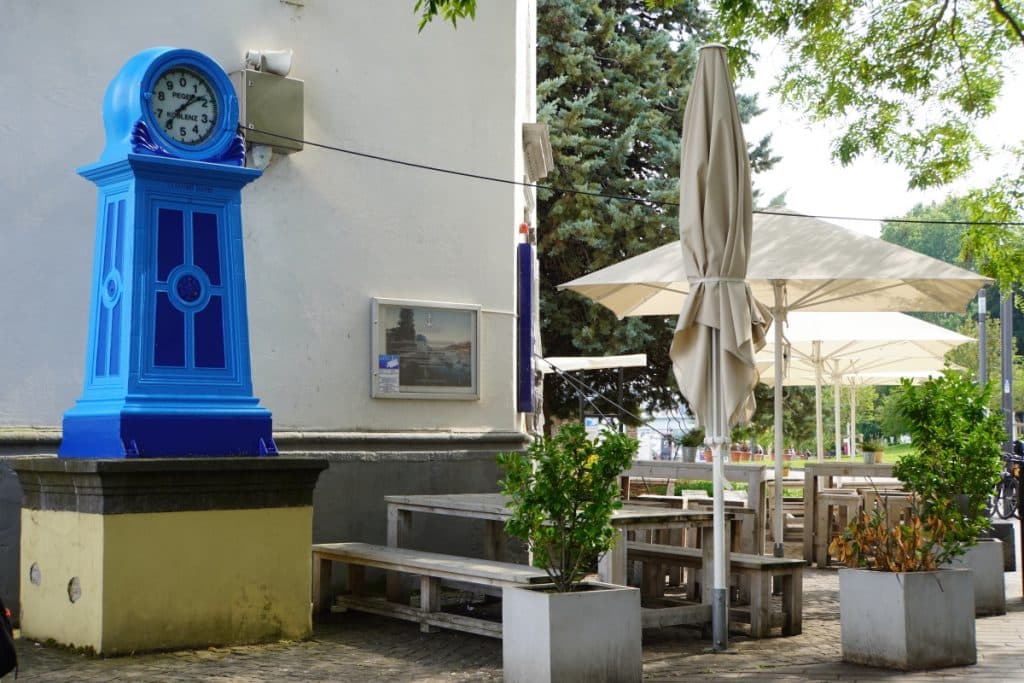
To determine the level of the Rhine, you needed the blue water level clock, which is located directly on the building. Admittedly, we initially stood a bit perplexed in front of the hands and were not really able to read the level of the Rhine. It was only after we had checked the current level online that the figures became clear to us. It is actually relatively simple: the large pointer shows the meter level and the small pointer shows the centimeter level.
Liebfrauenkirche (Church of Our Lady)
In the center of the old town, to be more precise on the highest point of the old town, stands the Catholic Church of Our Lady. Its high towers dominate the cityscape and the church is one of the sights in Koblenz that should not be missed.

The beginnings of the church date back to the 5th century and the church was the main parish church of the town for many centuries. Over time, the church building has been expanded and rebuilt several times.
During the French period in Koblenz, the church deteriorated visibly and could only be saved from demolition by a new roof (1808). This, however, changed the outer appearance a lot.

During the air raids on Koblenz, the church roof and the spires burned down. The walls and vaults remained intact, however, and so reconstruction could begin quite quickly. In the meantime, the exterior of the choir and the nave have been restored to the color scheme they had in the Middle Ages. The beautiful choir windows were installed in 1992.

I also find the late Gothic star-ribbed vault in the nave of the church beautiful. I have seen the unusual color design in very few churches so far. The altar of St. Nicholas in the southern aisle is the only old preserved altar in the church. Other furnishings, such as the tombs, date from the 15th-18th centuries. It is worthwhile to go on a little journey of discovery through the nave!

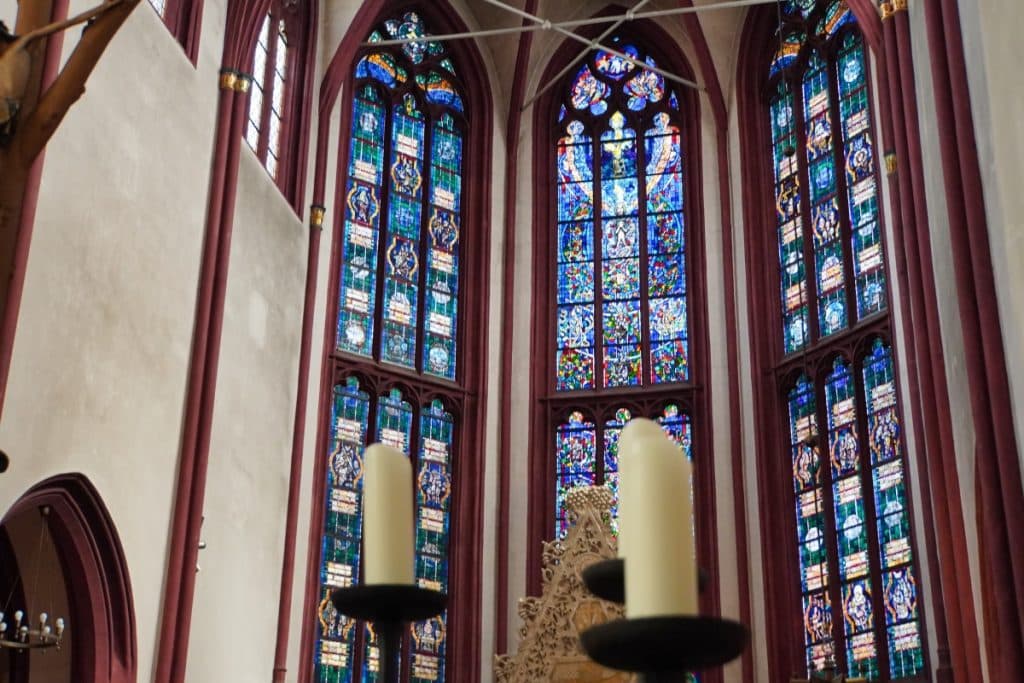
I find very exciting that for many years two tower guards were on duty in one of the church towers. In addition, there were 4 other night watchmen around the Liebfrauenkirche. They took turns reporting to the tower watchman every 15 minutes by pulling the tower bell. He then addressed them through the call pipe on the tower. The tower watchmen were on duty from 10 p.m. to 3/4/5 p.m. (depending on the season). If they saw a fire or if a night watchman reported a fire, they had to give alarm with the fire bell and the horn. If a fire broke out during the day, the sexton had to take over this task.
Jesuitenplatz (Jesuit Square)
For me, Jesuitenplatz is one of the most beautiful squares in Koblenz. The square got its name from the Jesuit order. They were resident there from 1580 – 1773 and had the Jesuitengymnasium built. This building, which looks almost like a castle, is today the town hall of the city. The former Jesuit church is now the City Church.


Basilica of St. Kastor
The Basilica of St. Kastor in the old town of Koblenz is the oldest preserved church building in the city. The church stands behind the German Corner on the headland where the Rhine and Moselle rivers meet.
Already in the times of Emperor Augustus (27 B.C. – 14 A.D.) there must have been a Roman fort on the site of today’s church. This can be proven by finds, which were discovered during construction work in 2008.

A church then existed from about the first half of the 9th century. There are records in which the monastery St.Kastor is mentioned as a meeting place of emperors and kings, where they negotiated disputes.
The reconstruction of the church to its present shape and size began around 1160. Numerous battles around Koblenz repeatedly caused destruction to the church. With the construction of the city wall, it was then protected from attacks.

In 1216, the archbishop of the time brought the knights of the Teutonic Order to Koblenz. He gave them part of the church grounds with the hospital there. He wanted to use their knowledge in nursing for the city. The administration of the Order’s province was established at the corner where the Moselle and Rhine rivers flowed together, and it was called Deutscher Ordt and later Deutsches Eck.

Over the years, some structural changes were made, always in line with the current trend of the time, such as the removal of the Baroque furnishings. Also the damages after the Second World War were removed and the church was rebuilt in accordance with the preservation order. Since 1991, the Chestor Church has been a Basilica minor elevated by the Pope.

If you approach the basilica from the city side, you will cross a large square. There stands the Kastorbrunnen since 1812. I really like the view of the two high 44 meter pilastered towers. If you come from the water side, you walk through a garden with beautiful flowers. A dreamlike place of peace where you can forget the time.


I felt something similar when I entered the nave. What a beautiful and wonderfully quiet space. Even though the interior looks somewhat disparate in parts due to the different construction phases, I really like it. Especially the star-ribbed vault of the rather wide nave impress me. In the apse I discover a fresco of the Holy Trinity in the dome (1849) and on one outer wall the image of grace from the 15th century. Walking through the basilica, I have the feeling to discover something from almost every century.
Florinsmarkt
Once upon a time… you could say that at Florinsmarkt, because this was once the political and economic center of Koblenz.
And today…? Today, the Florinskirche stands here, an ensemble of historic buildings and here is the “Augenroller”.

The Florin Church once belonged to the canonical monastery of St. Florin. In 1803 the church was secularized. In the following years, the building was used as a magazine and municipal slaughterhouse with stalls. After the Prussians took over the city, King Frederick William III gave the building to the Protestant military and civil parish. The former Catholic church was consecrated Protestant in 1820. It was the first Protestant church building in Koblenz.

The historical buildings are the old “Kauf- und Danzhaus”, the Gothic “Schöffenhaus” and the “Bürresheimer Hof”. The old “Kauf- und Danzhaus” was built in 1419 in Gothic style and rebuilt in the 17th/18th century in Baroque style. Until 2012, the Mittelrhein Museum was located there. In the Gothic Schöffenhaus, the aldermen of the city court once met and the Bürresheimer Hof was a residential building.

My personal highlight at the Florinsmarkt, however, is the Augenroller, one of the more inconspicuous sights in Koblenz. A head can be seen under a tower clock. The eyes wobble from right to left every second, much like the pendulum of a clock. In addition, the figure sticks out its tongue every half and full hour. The eye roller is supposed to remind of the robber baron Johann Lutter von Kobern. He was executed on the square in 1536. According to legend, the severed head twisted his eyes and stuck out his tongue in front of the gawking crowd.

Balduin Bridge
Large, stable and powerful, the stone arch bridge looks to me. The oldest preserved bridge in Koblenz dates back to the 14th century. It is the last bridge to cross the Moselle before it flows into the Rhine and today connects the old town with the Lützel district.
The construction of the bridge was initiated by Elector Balduin of Luxembourg in 1342/43, who also gave the bridge its name. It took about 85 years to complete the Balduin Bridge with its fourteen arches with thirteen piers.

The bridge suffered varying degrees of damage over the years due to flooding and ice, but remained standing until the end of the Second World War. In 1945, the Wehrmacht blew up all of Koblenz’s bridges. 3 arches of the Balduin Bridge collapsed. As quickly as it was possible, they rebuilt the connection across the river.
Then, in the 1960s, part of the bridge had to make way for a modern prestressed concrete bridge. The Moselle was canalized to accommodate modern shipping traffic. The remaining arches were widened, creating a bridge almost twice as wide as the original in the Middle Ages. Today, a stone statue commemorates the eponymous elector.
Explore sights in Koblenz: the Middle Rhine Museum
Since 2013, the Middle Rhine Museum has been located in the Forum Confluentes, a modern and architecturally very interesting building.


An art-loving priest had collected a good 200 paintings during his lifetime. In 1834, shortly before his death, he bequeathed these to the city of Koblenz, which found a suitable exhibition space. The holdings grew through the merging of collections and further donations, and over time more and more space was needed, so that the collection moved several times.


During the Second World War, attempts were made to protect the plants as best they could. Nevertheless, some were destroyed, lost or became “loot” of the Allies. The remaining holdings were made accessible again from 1949 to 1965 under the new name Mittelrheinisches Museum, initially in Ehrenbreitstein Fortress. In 1965, the museum moved to the buildings on Florinsmarkt, which had been rebuilt and converted for museum purposes. Since 2013, the exhibition can now be viewed in the Forum Confluentes.


We looked around a bit in the museum. I particularly liked the paintings that have a regional connection and depict the Rhine, the Moselle and Koblenz. Here you can discover wonderful impressions of historic Koblenz, which the artists have skillfully captured. Not to be missed is the large city model that illustrates the structure of Koblenz very well.
We discovered the sights in Koblenz in cooperation withKoblenz-Touristik GmbH .

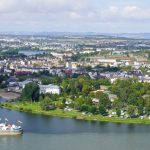

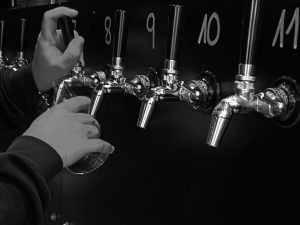





Leave a Reply